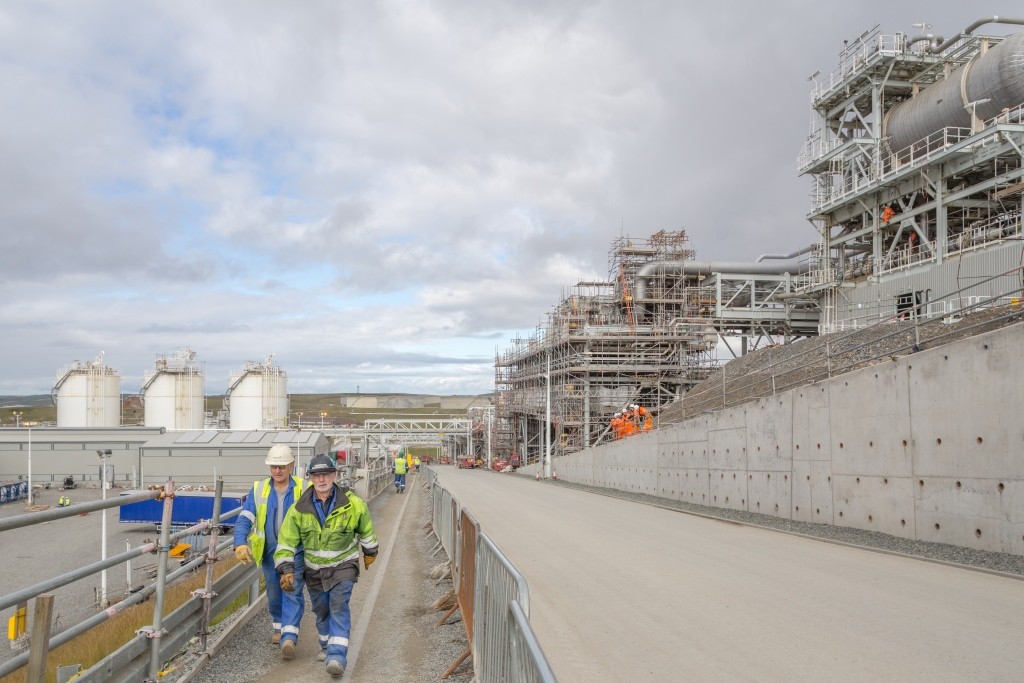Oil and Gas: Regaining a Foothold?
It is by no means a triumphant Rocky moment. Oil executives are not pummelling meat in a storage locker and dancing on the town hall steps. It is more of a sneaking suspicion, a willingness to suspend disbelief once you’ve gone through the mirror.
Could the oil and gas industry be ready for a renaissance? Well . . . the signs beg candor. And yet some suggest a warming trend for the foreseeable future. As always, of course, there are various indicators that could play significant roles in hindering recovery.

The Shetland Gas Plant (SGP) during construction, 2015
Let’s proceed with cautious optimism. Much of the oil and gas industry has survived especially tough few years of weak demand and low prices. It has been difficult to make strategic decisions and plan for the future.
On the upside, OPEC remains unified in the face of the largest crises the industry has seen in some time. Some better general macroeconomic statistics hint that things are moving in the right direction. Optimism lurks amongst inquiries and surveys instigated by the industry.
Beginning in June 2014 the oil price collapse caused companies to cut capital spending by 40% into 2016 and lay off 400,000 workers worldwide. Major projects were cancelled or postponed. Costs were closely observed with greater efficiency in mind. The result is that a growing number of projects can break even with oil prices in the high 20s. What an improvement! Development costs in Statoil’s North Sea field have been reduced to $25 per barrel.
The Aberdeen and Grampian Chamber of Commerce conducted one important study. This organisation has a reputation for cogent probing of the market over the decades. The institution, as noted by the BBC, which has high expectations for 2018 as the industry treads towards recovery. High profile managers suggest that layoffs are ending. The share of companies increasing employment is up to 30%. This is up from 8% in 2016.
The unemployment rate in Scotland has fallen by 0.3 percentage point in Q2 to 3.8% in Q3, which is below the UK average of 4.3%. The clouds are receding.
The aforementioned report also says that wages in the period ended up at 2.1% higher, measured year to year whilst inflation rose to 2.9% in August.
Wages are unfortunately failing to keep up in real terms. They have dipped by 0.4%. So it seems reasonable to derive from these indicators that the sector is growing yet still fails to keep pace with the general economy.
Oil and Gas have lately been experiencing some continuing hiccups. However, the industry still commands a substantial tranche of more than 302,000 jobs in the UK— both direct and indirect.
Most oil and gas jobs are spread across the country: almost 60% in England, 38% in Scotland and the remainder across Northern Ireland and Wales. The highest employment level in the sector was in 2014 when it reached 460,000. Current estimates lower it by 160,000 underlining that it is still a very important part of the British industry, creating numerous indirectly related jobs.

Central European Staffing employees at work in Shetland, 2015
It is estimated that more than 141,900 jobs are supported with no direct connection to the industry itself (for example eating establishments, as well as 132,000 industry induced jobs related to legislation, administration and the like).
A further important finding (Workforce Report 2017) is that the pace of contraction in employment has slowed considerably to 4.2% between 2016 and 2017, compared to 15.6% from 2015 to 2016, and even worse in 2014 to 2015, when it stood at 19.4%.
It should be no surprise then, that an opinion poll conducted between April and October 2017 found confidence mounting in nearly 49% of inquiries, up from 38% for the previous six months. Additionally, companies operating at their optimum level of workload or even exceeding expectations rose from 12% to 27% in the past year.
Meanwhile, companies working on the UK Continental Shelf (UKCS) have increased their production by 42% per core offshore worker, those spending more than 100 days on projects, since 2014.
An interesting fact is that some 15% of workers in the UK Oil and Gas industry are now non-British citizens. Most come from EU countries. The labour force is also growing older with the average age now of 42.7, which is a jump from 40.7 since 2014.
From 2014 to 2016 the core offshore workforce fell from 28,990 to 23,651, a decrease of 18%.
The West Shetlands region has experienced the greatest development in offshore staffing since 2014. It doubled the number of offshore workers to 4,304 in 2016.
Moreover, companies have had to invest in areas such as the North Sea in order not to lose their drilling license, which is subject to a start date. If a company fails to commence drill operations within a given time period, it could have its license revoked.
There is also an increase in decommissioning projects for the offshore/onshore platforms and facilities that have outlived their industrial span.
On the debit side, of course, one can posit that the oil price rise above $50 to approximately $63 is short-lived. It may be that the price has gone up merely due to the cuts in crude oil production.
The good news is that the oil and gas industry is hiring again. This latest sign of recovery in oil and gas after the 2014 price crash reinforces the belief that a good proportion of oil and gas companies have successfully adjusted to the new level of oil prices, which are still more than 50% below the 2014 highs.





